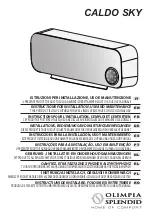
Models 24-CGA-10 and 24-CEA-10
SteamCraft 10 Service Manual, Chapter 8
203
Ground Control System
The igniter, flame sensor and ignition module must share a
common ground with the main burner. Use thermoplastic
insulated wire with a minimum rating of 105º C (221º F) for
the ground wire; asbestos insulation is not acceptable. If
necessary, use a shield to protect the wire from radiant heat
generated by the burner. Connect the ground wire as follows:
1.
Fit one end of the ground wire with a female ¼ in.
quick-connect terminal and connect it to the male
quick-connect GND (BURNER) terminal on the
ignition module.
2.
Strip the other end of the wire and fasten it under the
igniter bracket mounting screw: If necessary, use a
shield to protect the ground wire from radiant heat.
3.
The burner serves as the common grounding area. If
there is not good metal-to-metal contact between the
burner and ground, run a lead from the burner to
ground.
NOTE: “Earth” ground is not required.
REPLACING MODULE WITH TH-R, TH-W
TERMINALS
On modules that do not have a vent damper plug, the
thermostat must be connected between the transformer.
and the 24V terminal on the module. To change out a
module with TH-R, TH-W terminals:
1.
Remove the wires from the 25V (2) and TH-R
terminals on the old module. Connect these two
wires with a solderless connector.
2.
Tag and remove the remaining wires from the
old module.
3.
Remove the old module and mount the new one
in the same location.
4.
Reconnect the remaining wires as shown in
Table 4.
5.
Increase the termostat anticipator setting by 9.2
A.
TABLE 4—T
ERMINAL
CROSS REFERENCE
TERMINAL ON OLD
MODULE:
TERMINAL ON NEW
MODULE:
25V(1)
T H-W
MV
MV/PV
PV
GND (Burner)
24 V (GND)
24V
MV
MV/PV
PV
GND (Burner)
CHECKOUT
Check out the gas control system:
•
At initial installation of the appliance.
•
As part of regular maintenance procedures. Maintenance
intervals are determined by the application. See
PLANNING THE INSTALLATION, page 1, for more
information.
•
As the first step in troubleshooting.
•
Any time work is done on the system.
WARNING
FAILURE TO HEED THESE WARNINGS MAY CAUSE FIRE
OR EXPLOSION WITH PROPERTY DAMAGE, INJURY, OR
LOSS OF LIFE.
1.
If you smell gas or suspect a gas leak, turn off gas at manual
service valve and evacuate the building. Do not try to light
any appliance, do not touch any electrical switch or
telephone in the building until you are sure no spilled gas
remains.
2.
Gas leak test must be done as described in Steps 1 and 5
below on initial installation and anytime work is done
involving the gas piping.
ST EP 1: Perform Visual Inspection.
?With power off, make sure all wiring connections are clean and
tight.
?Turn on power to appliance and ignition module.
?Open manual shutoff valves in the gas line to the appliance.
?Do gas leak test ahead of gas control if piping has been disturbed.
GAS LEAK TEST: Paint pipe joints with rich soap and water
solution. Bubbles indicate gas leak. Tighten joints to stop leak.
Recheck with soap and water.
STEP 2: Review Normal Operating Sequence and Module
Specifications.
?See OPERATION, page 12, and APPLICATION, page 1.
Step 3: Reset the Module.
?Turn the thermostat to its lowest setting.
?Wait one minute.
As you do steps 4 and 5, watch for points
where operation deviates from normal. Refer
to Troubleshooting Chart to correct problem.
Step 4: Check Safety Shutoff Operation.
This step applies to lockout and continuous retry
modules only.
?Turn gas supply off.
?Set thermostat or controller above room
temperature to call for heat.
?Watch for spark at pilot burner either
immediately or following prepurge. See
device label.
?Time spark from start to shutoff. See device
label. On S8600M, wait 6 min. nom. Ignition
sequence should start again followed by
shutoff after 90 sec. Max.
?Open manual gas cock and make sure no gas
is flowing to pilot or main burner.
?Set thermostat below room temperature and
wait one minute before continuing.
STEP 5: Check Normal Operation.
?Set thermostat or controller above room
temperature to call for heat.
Cleveland Range. Inc.
Printed 3/93









































